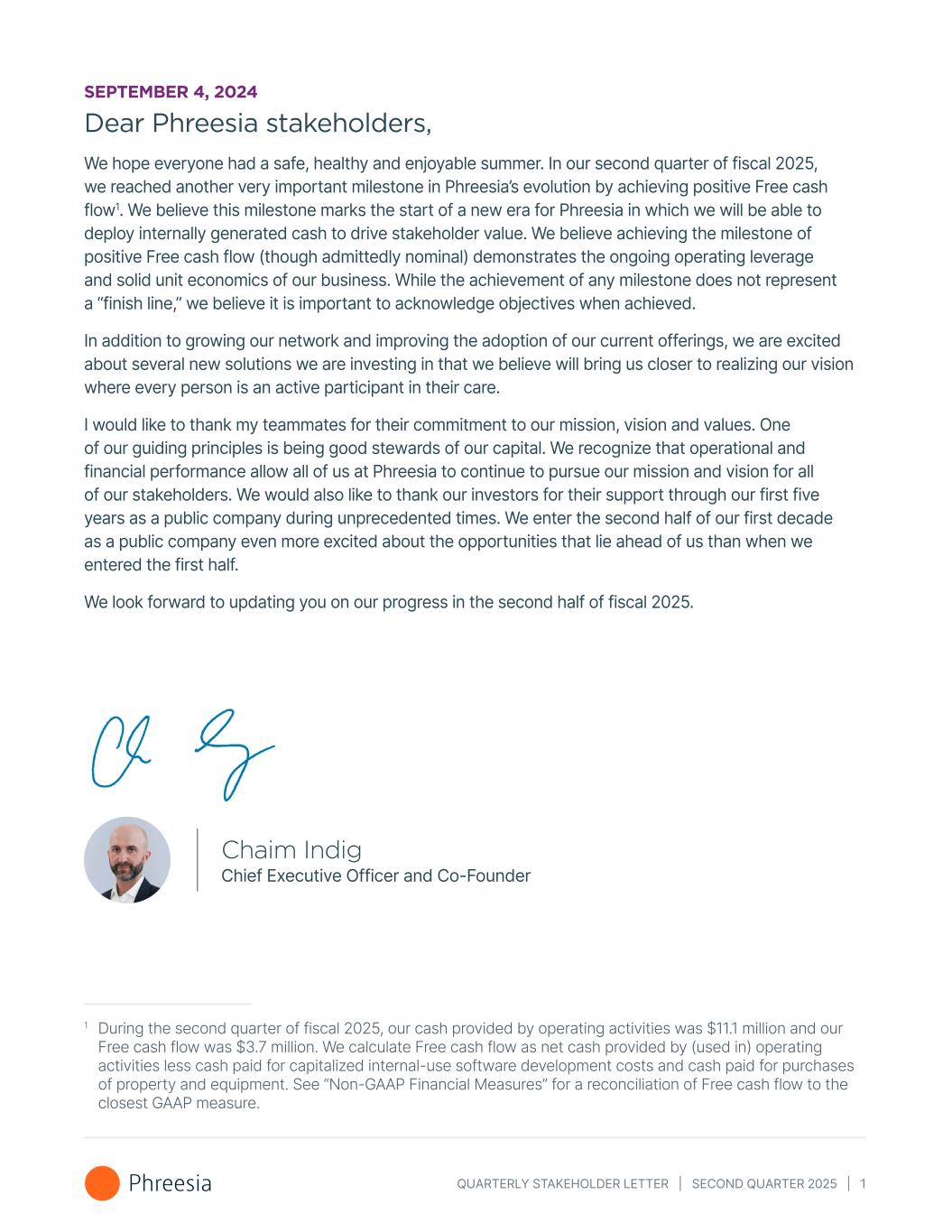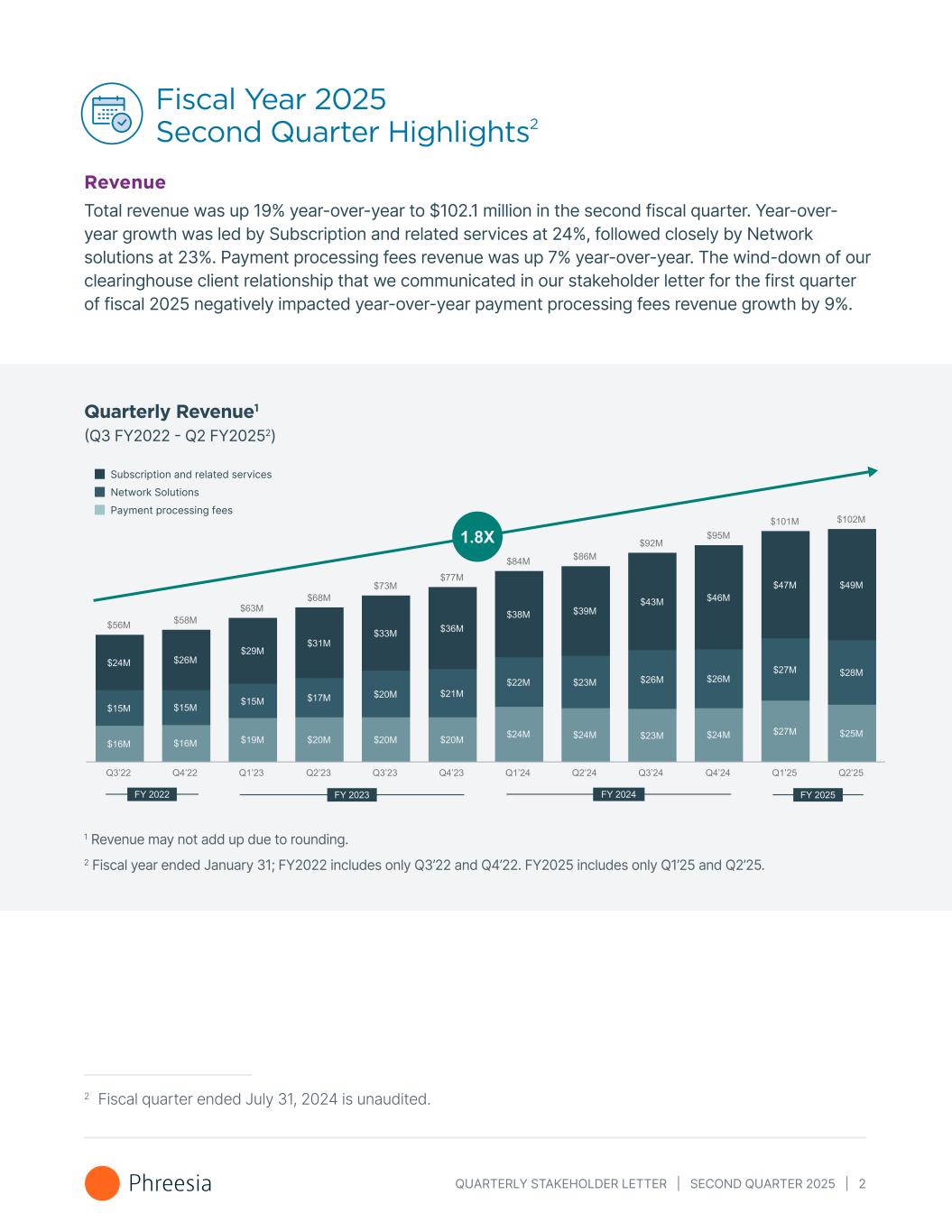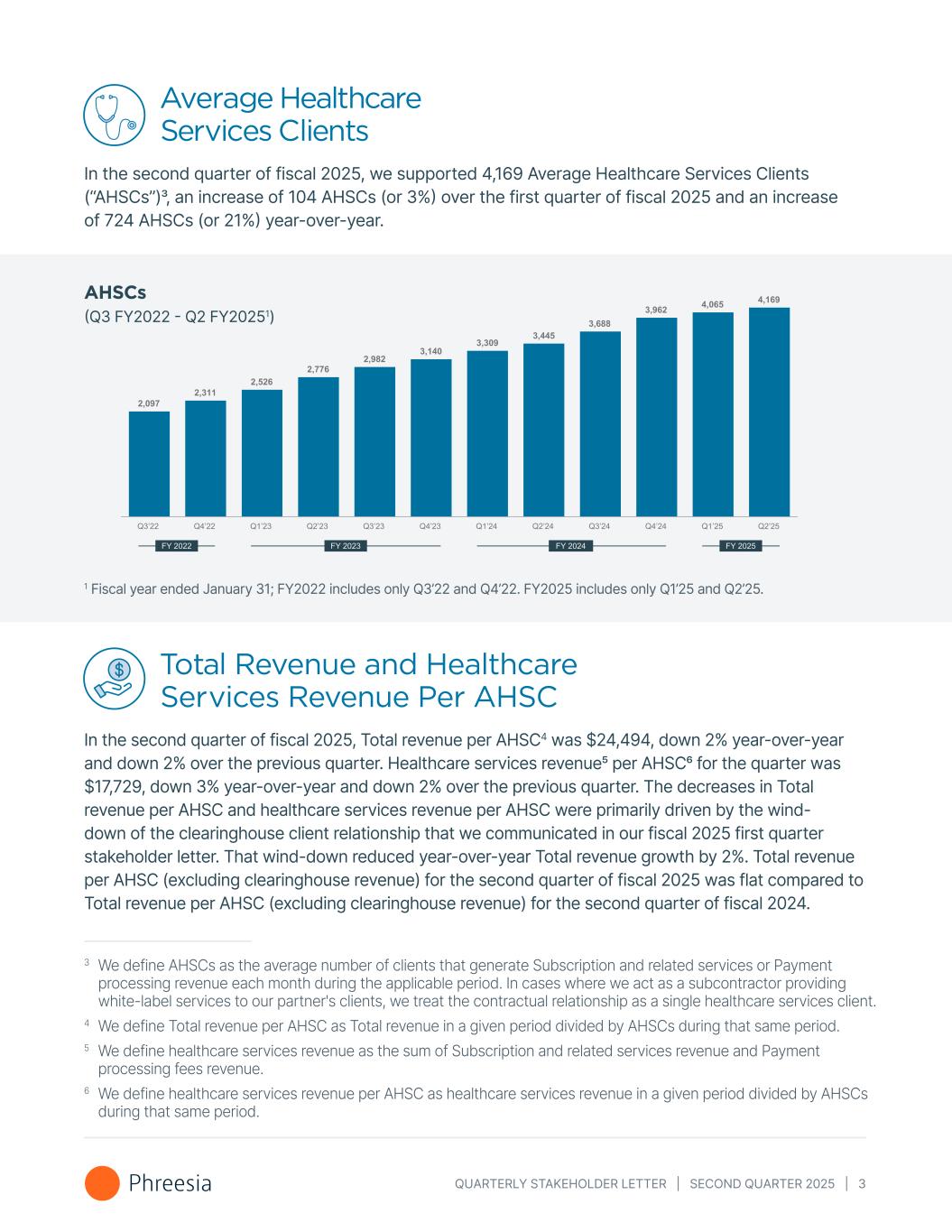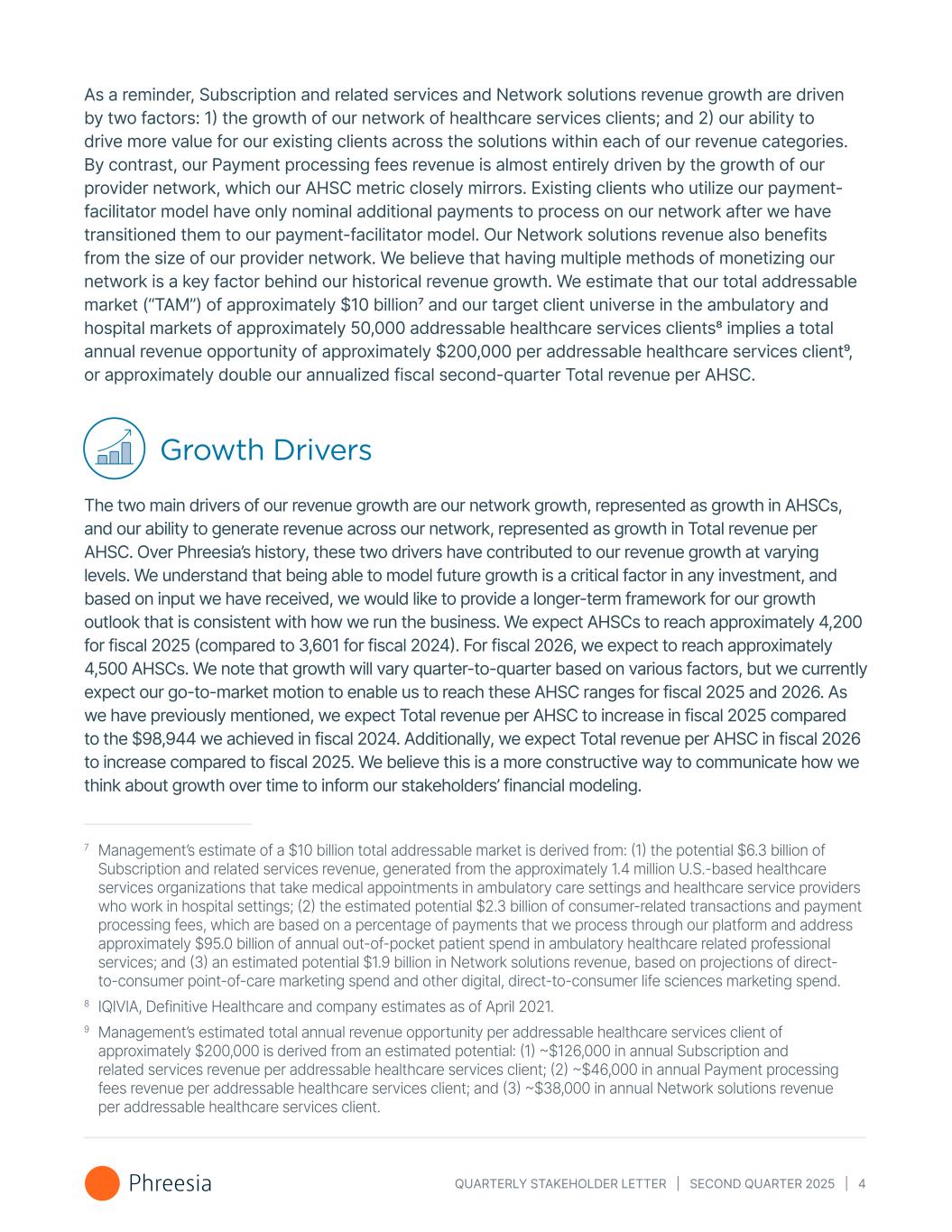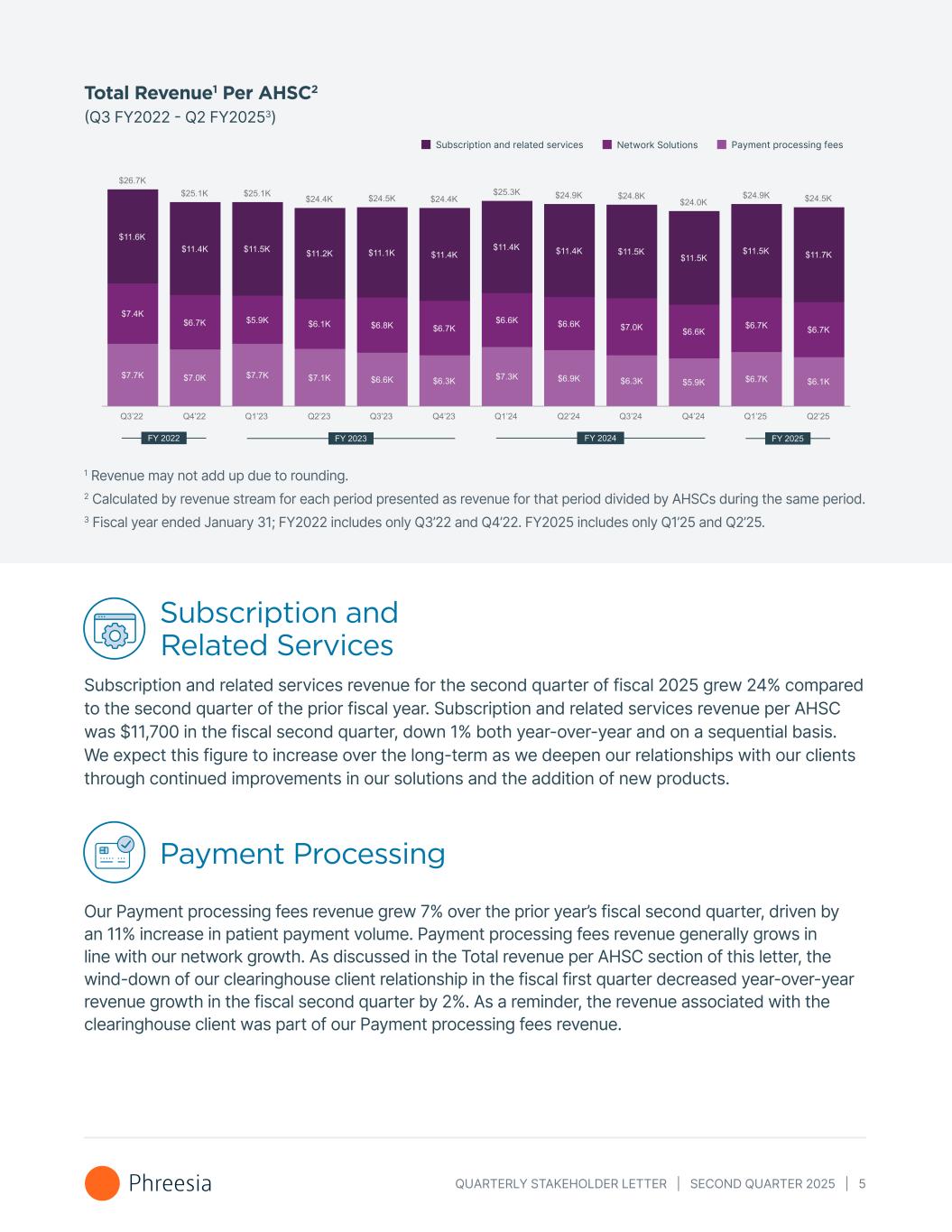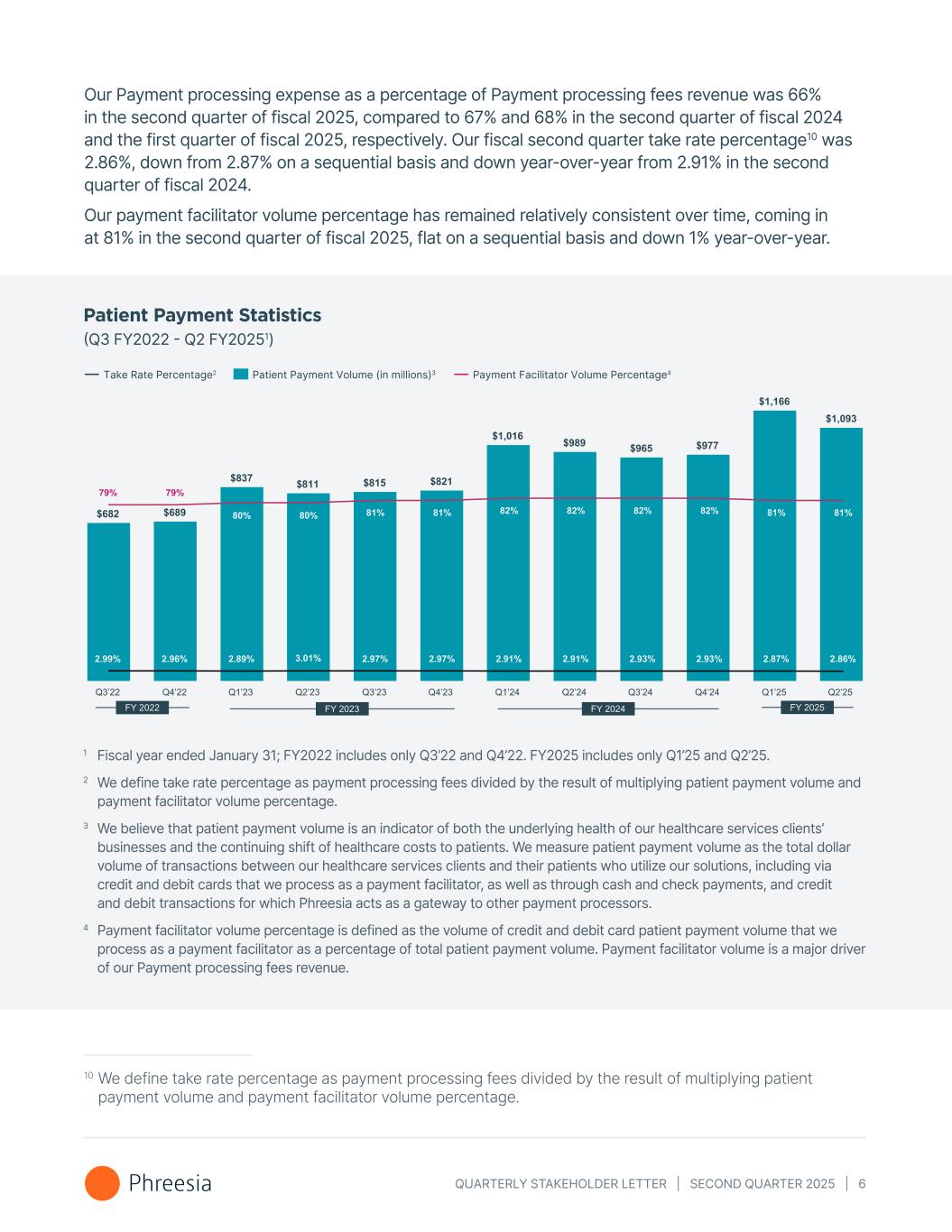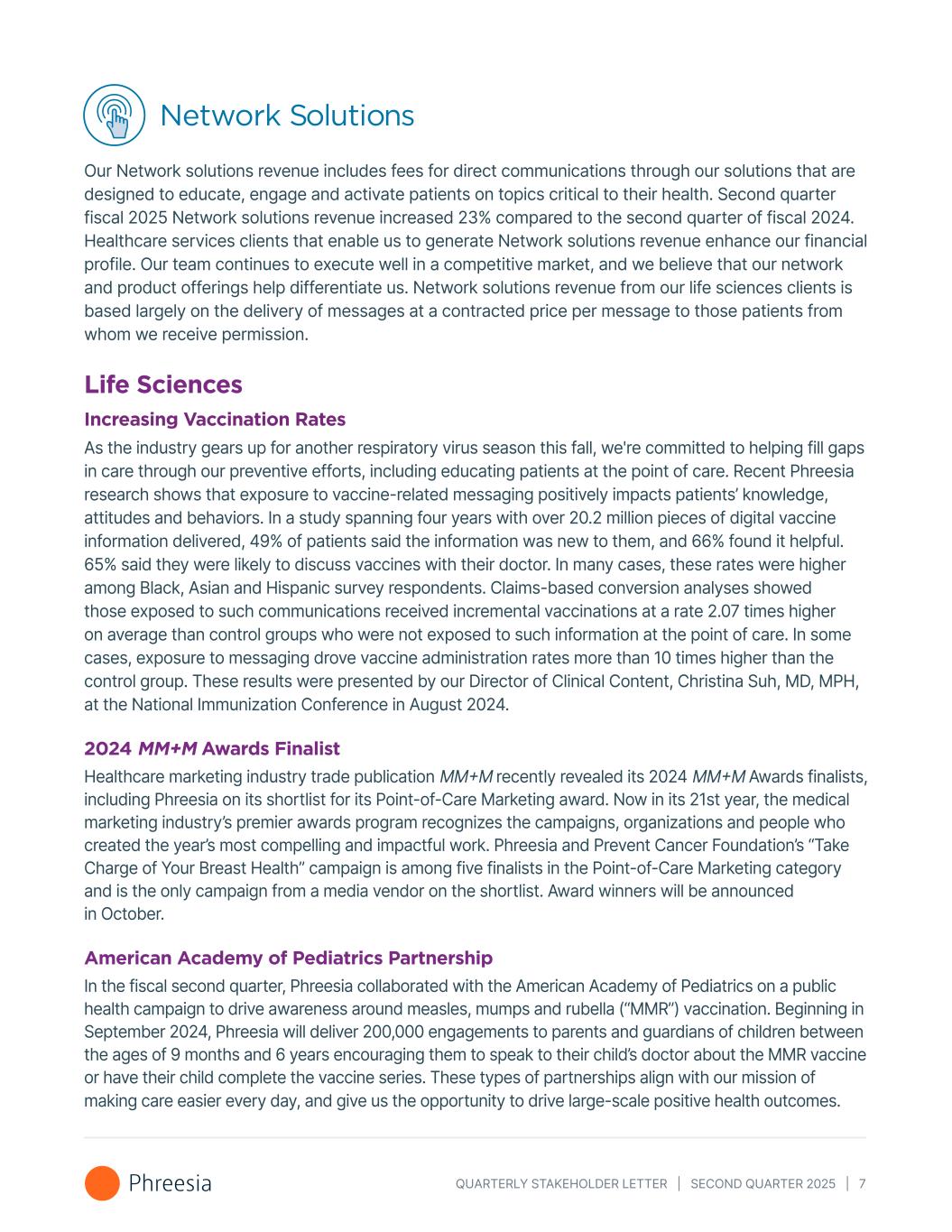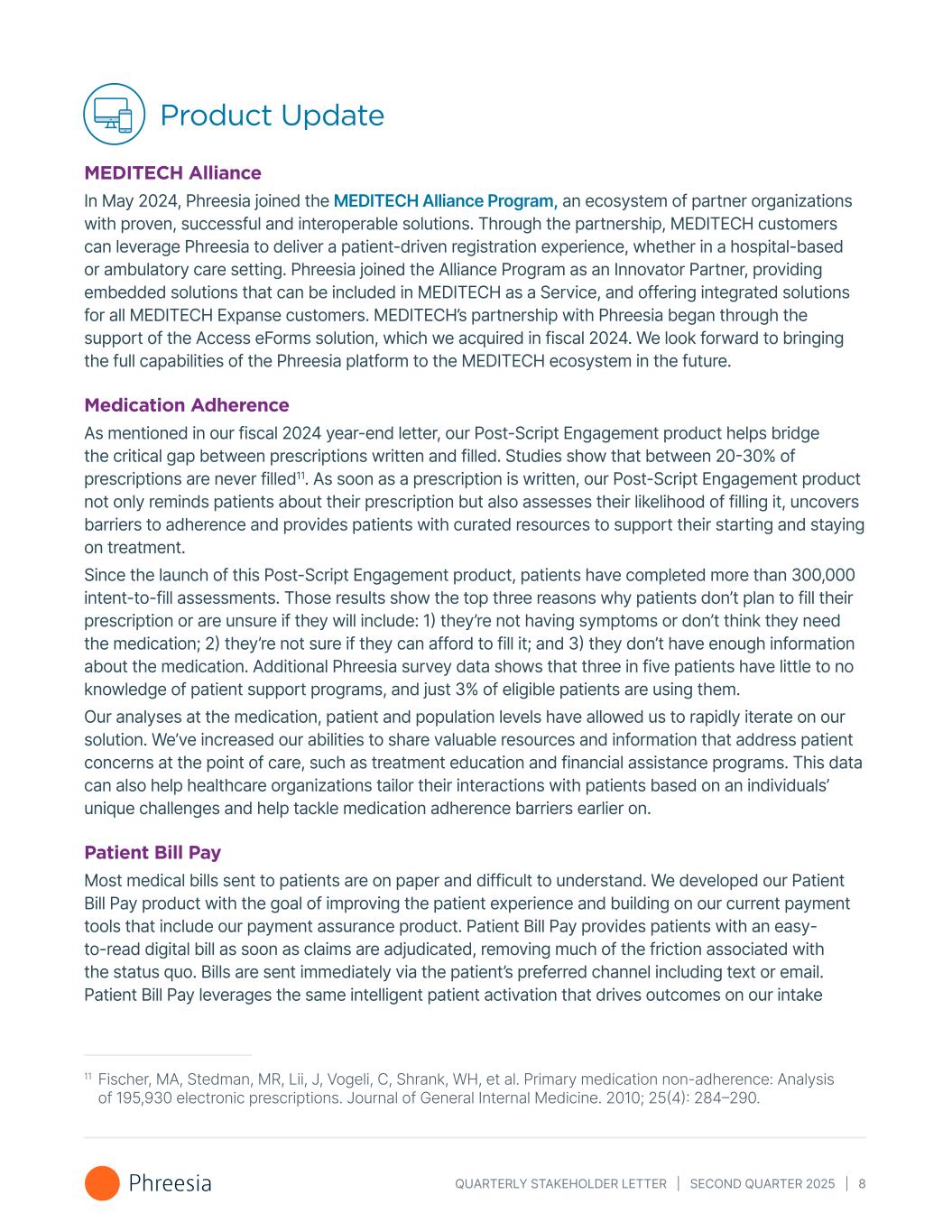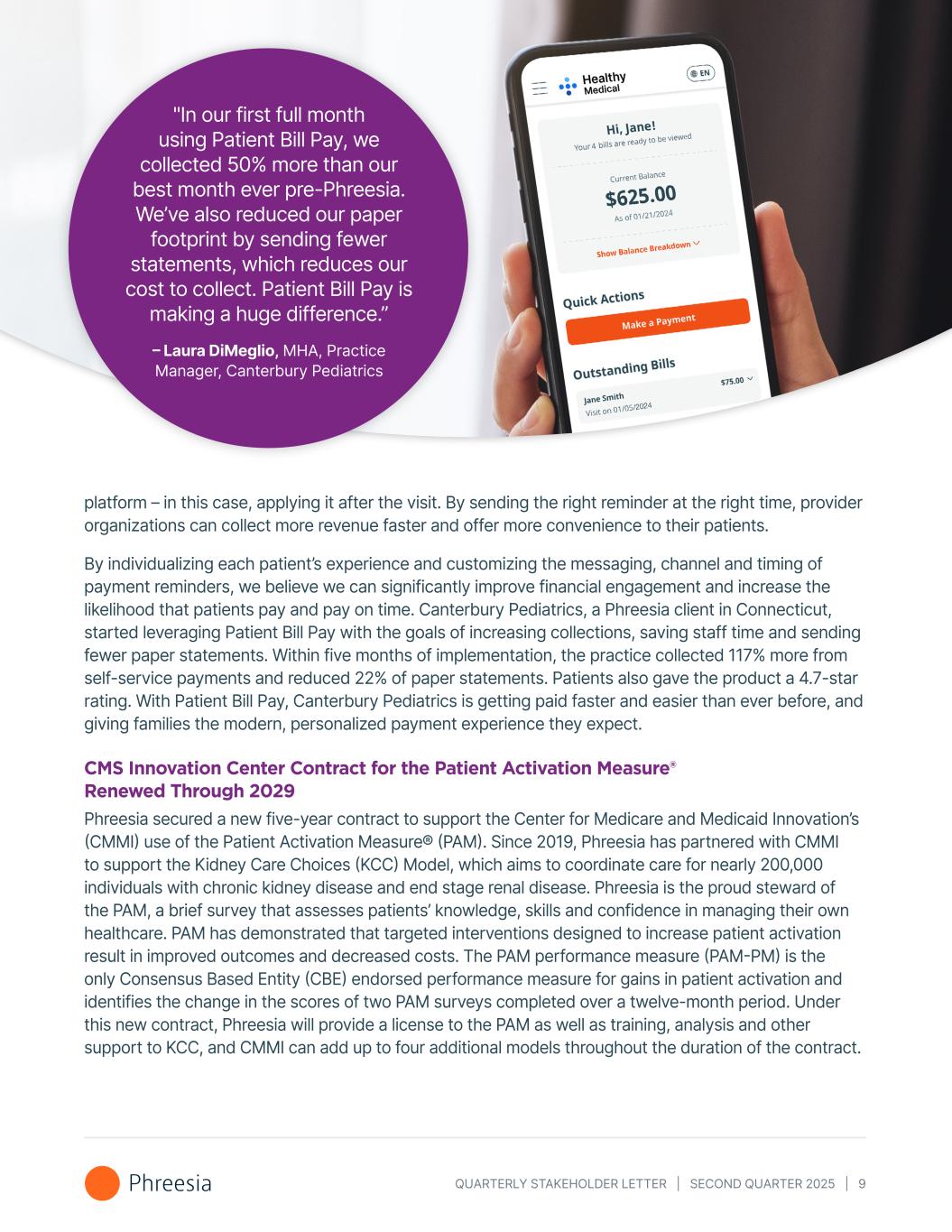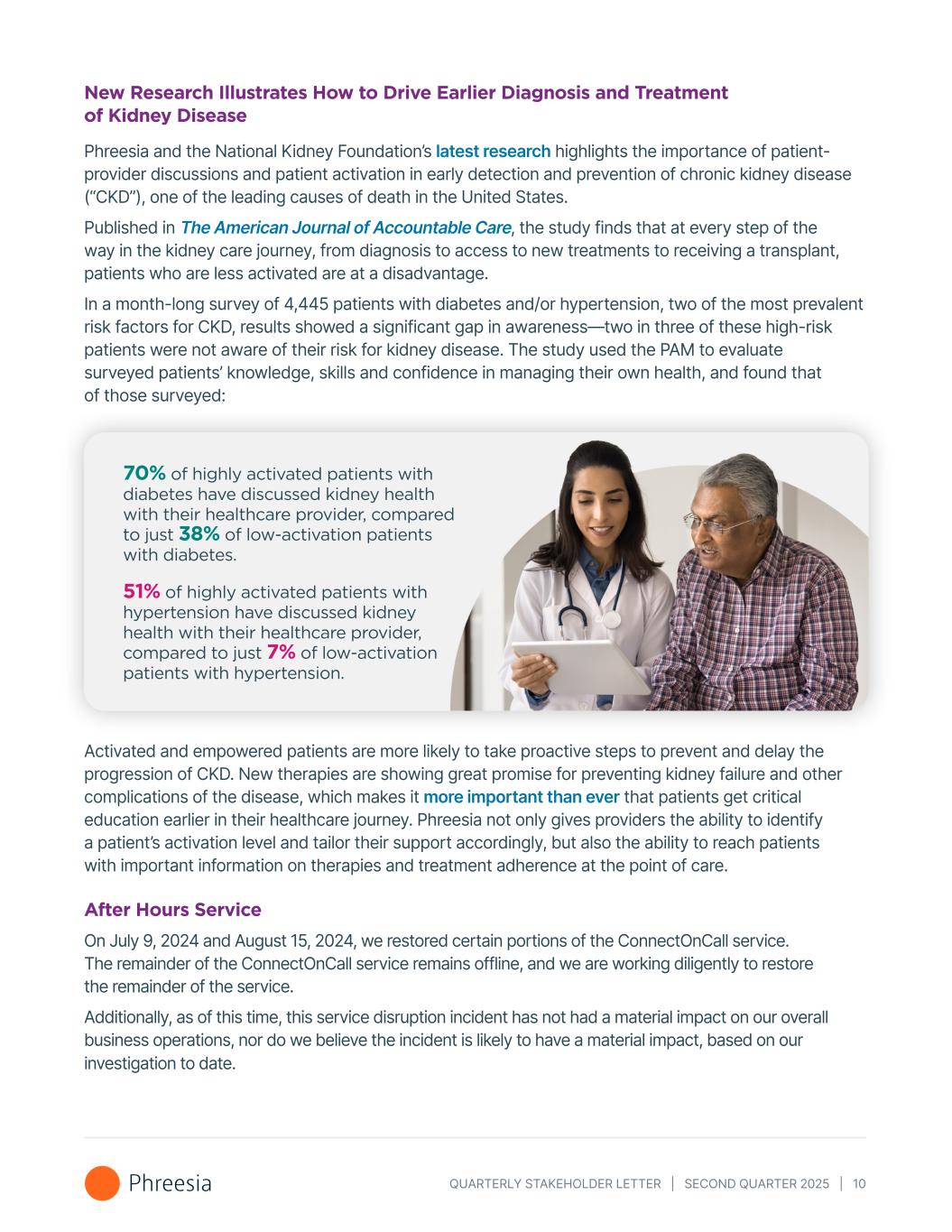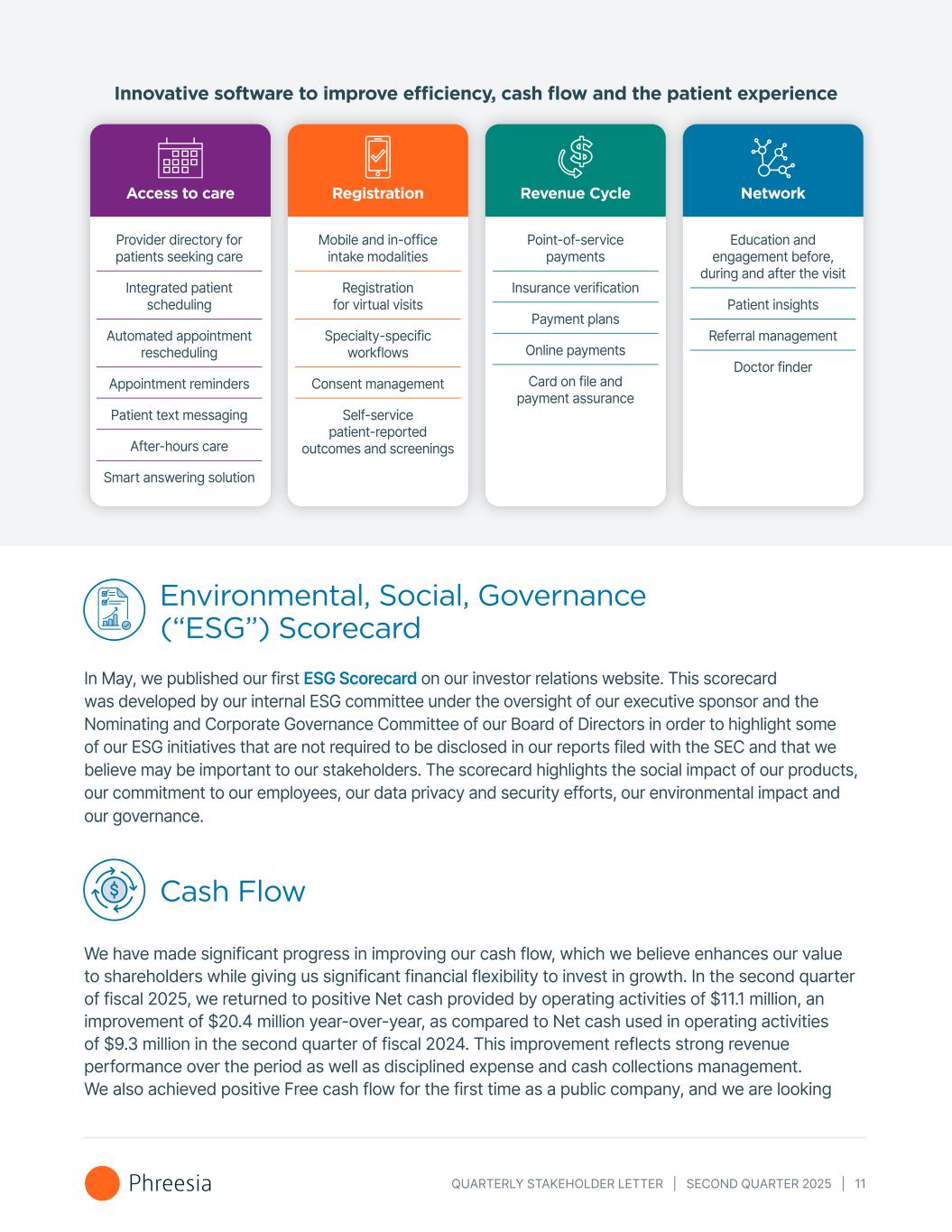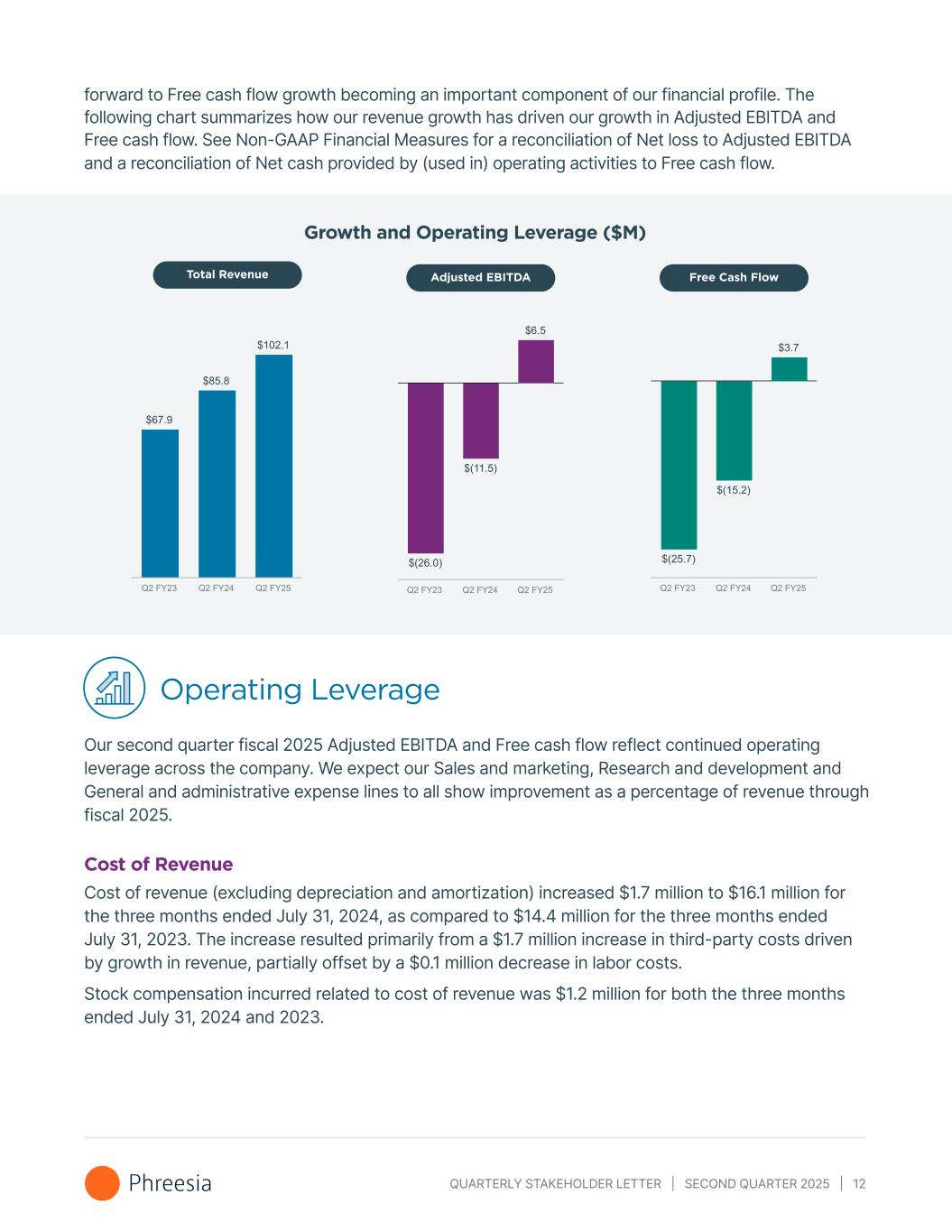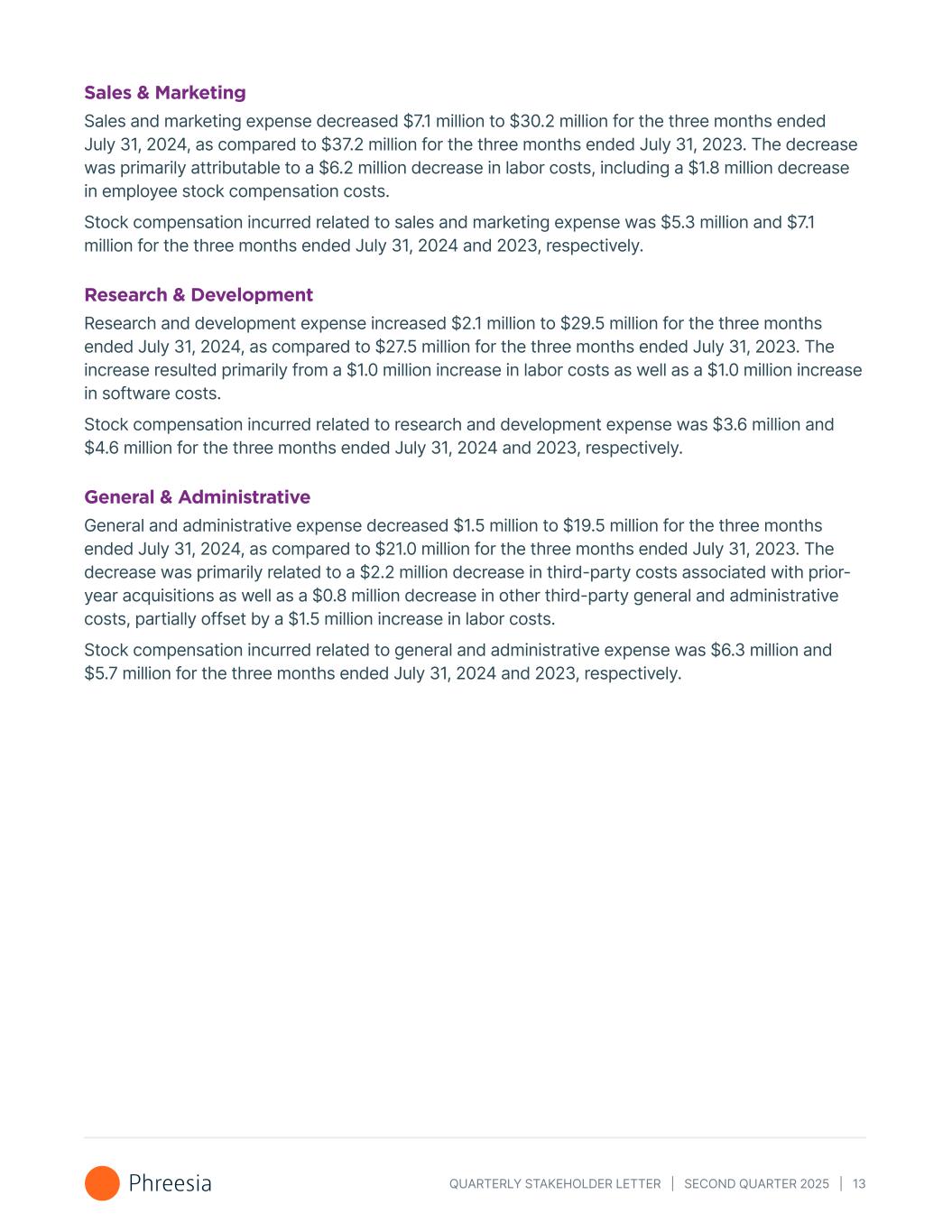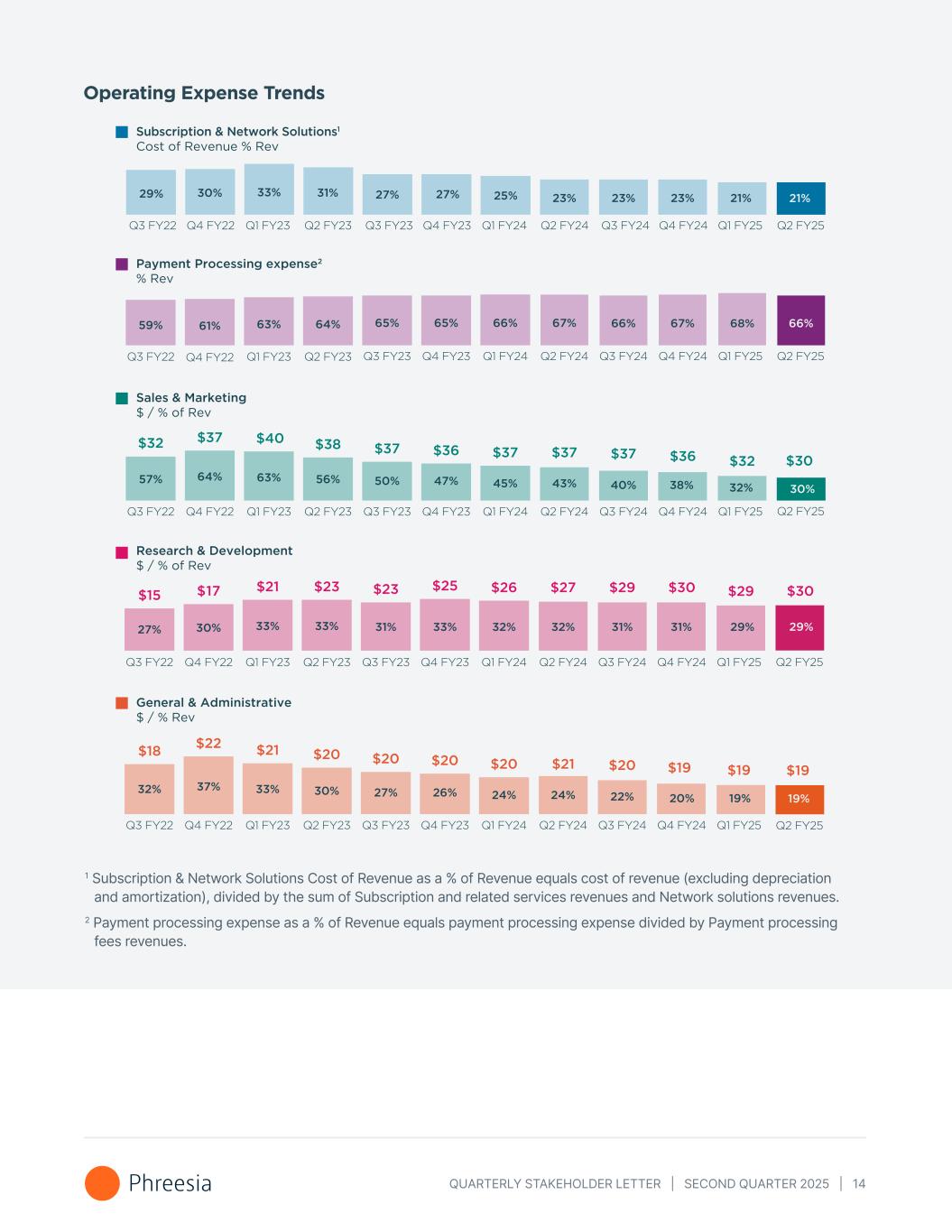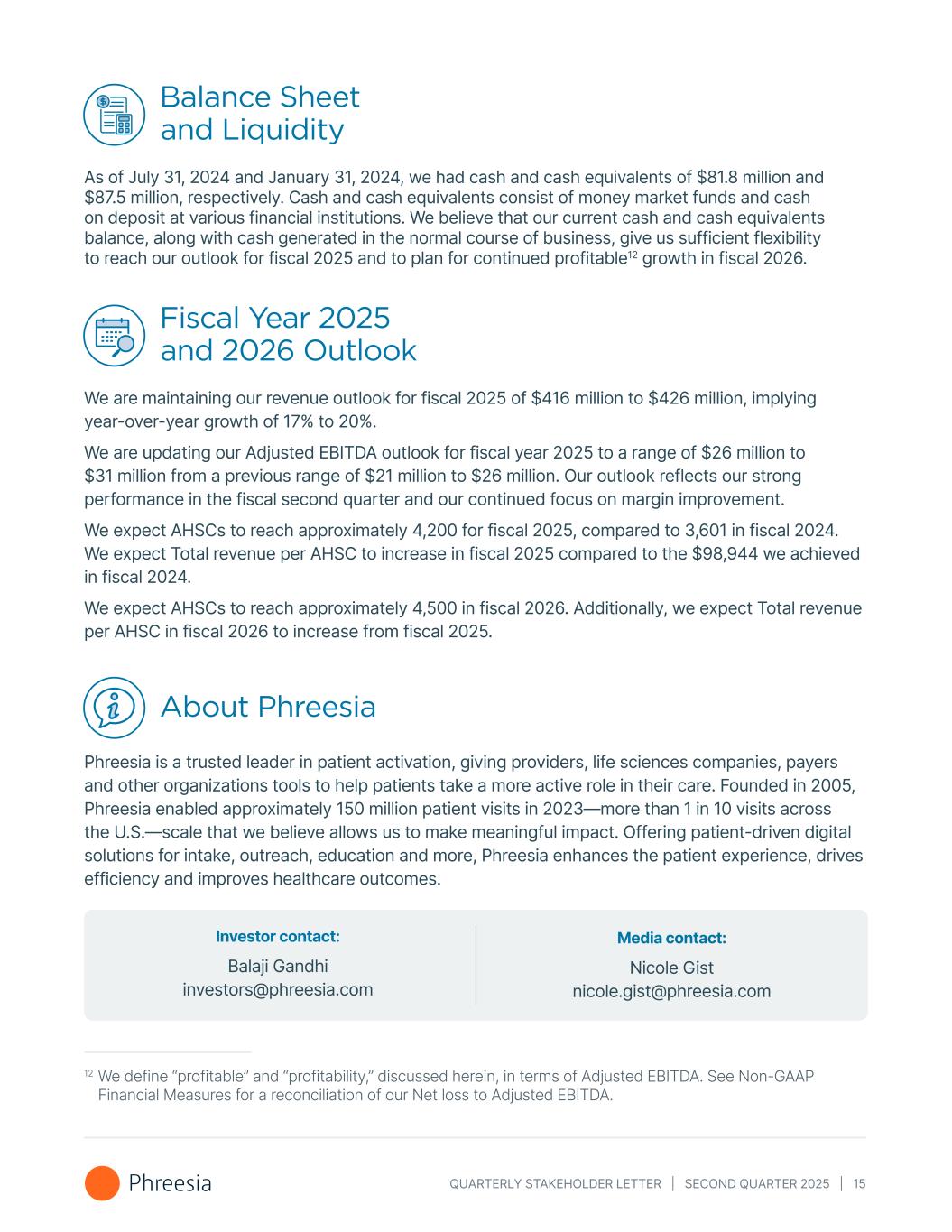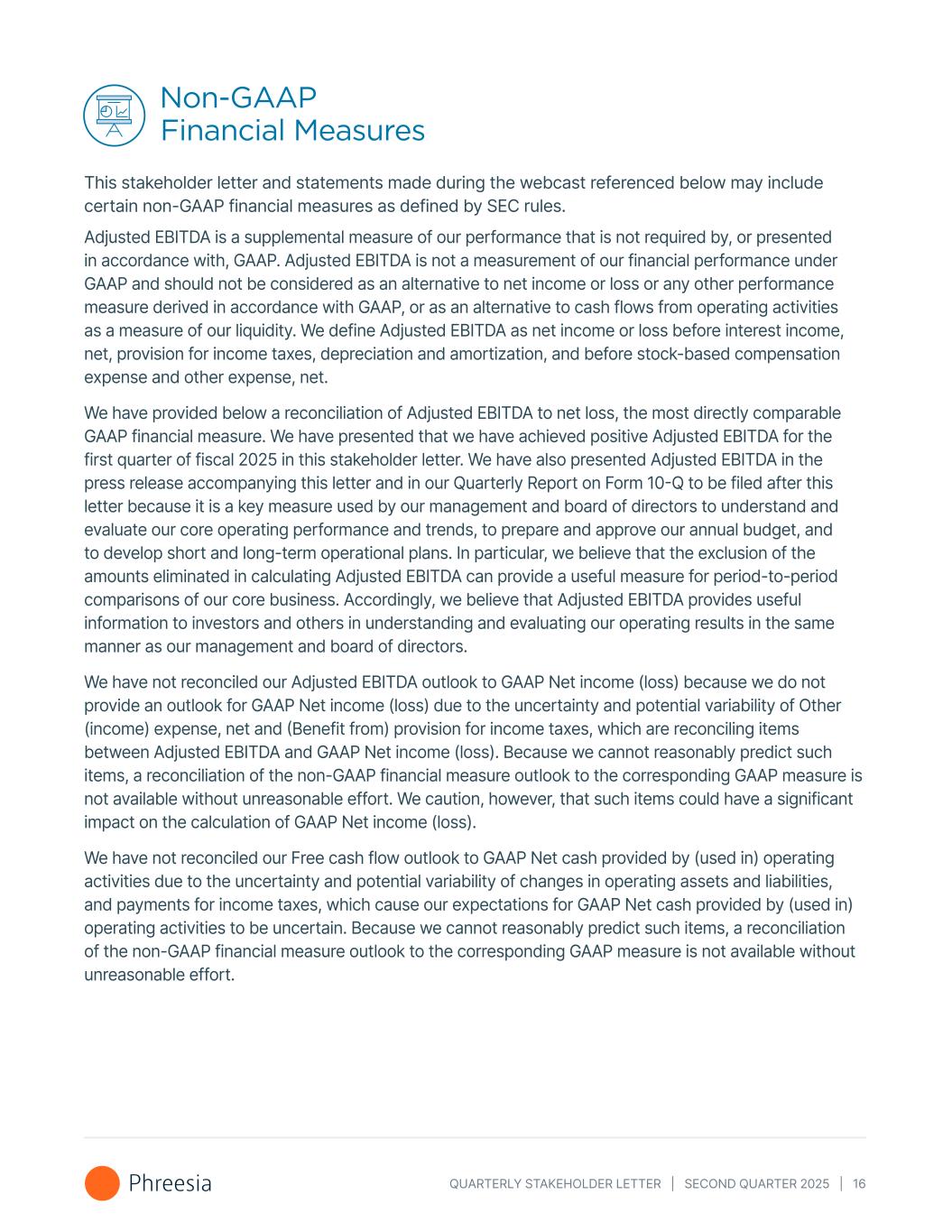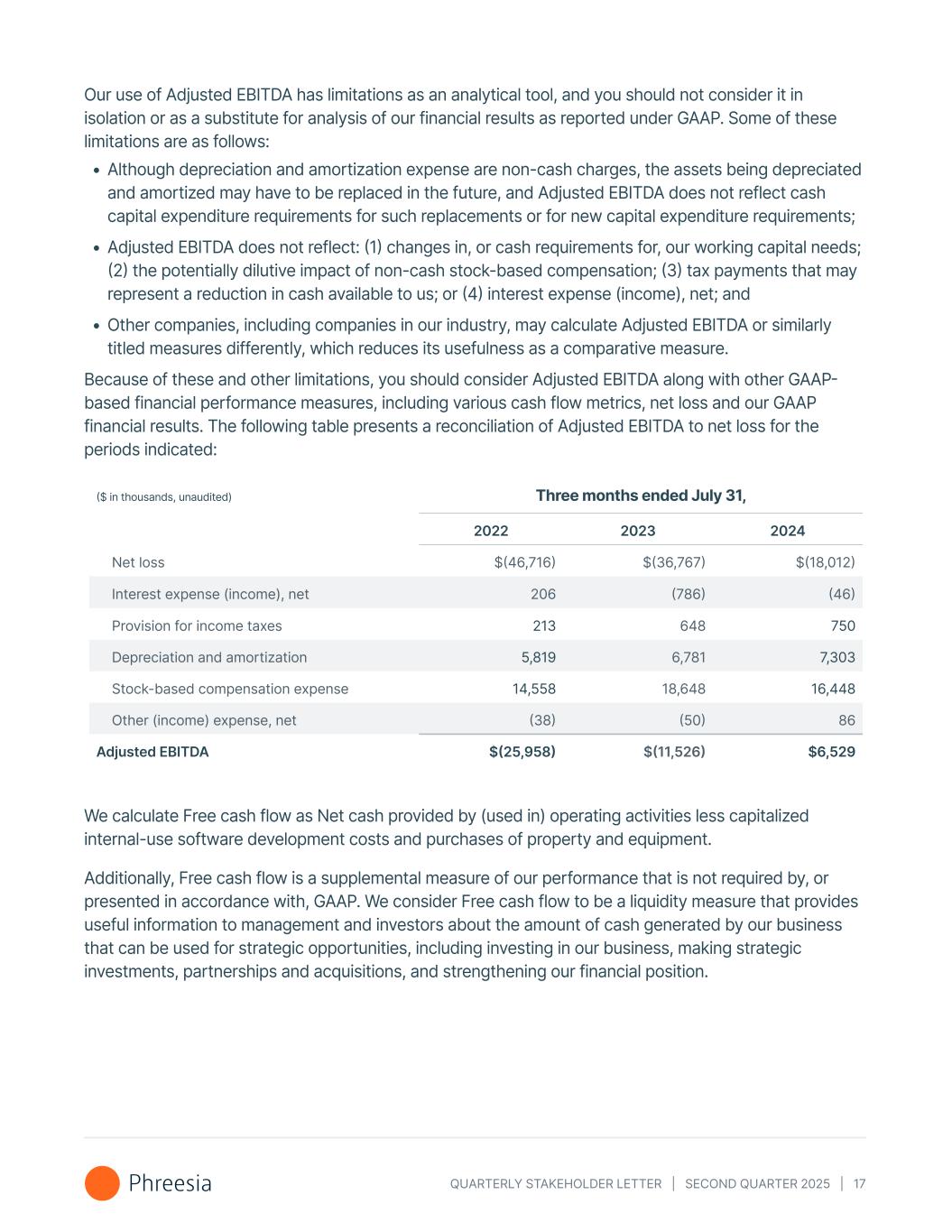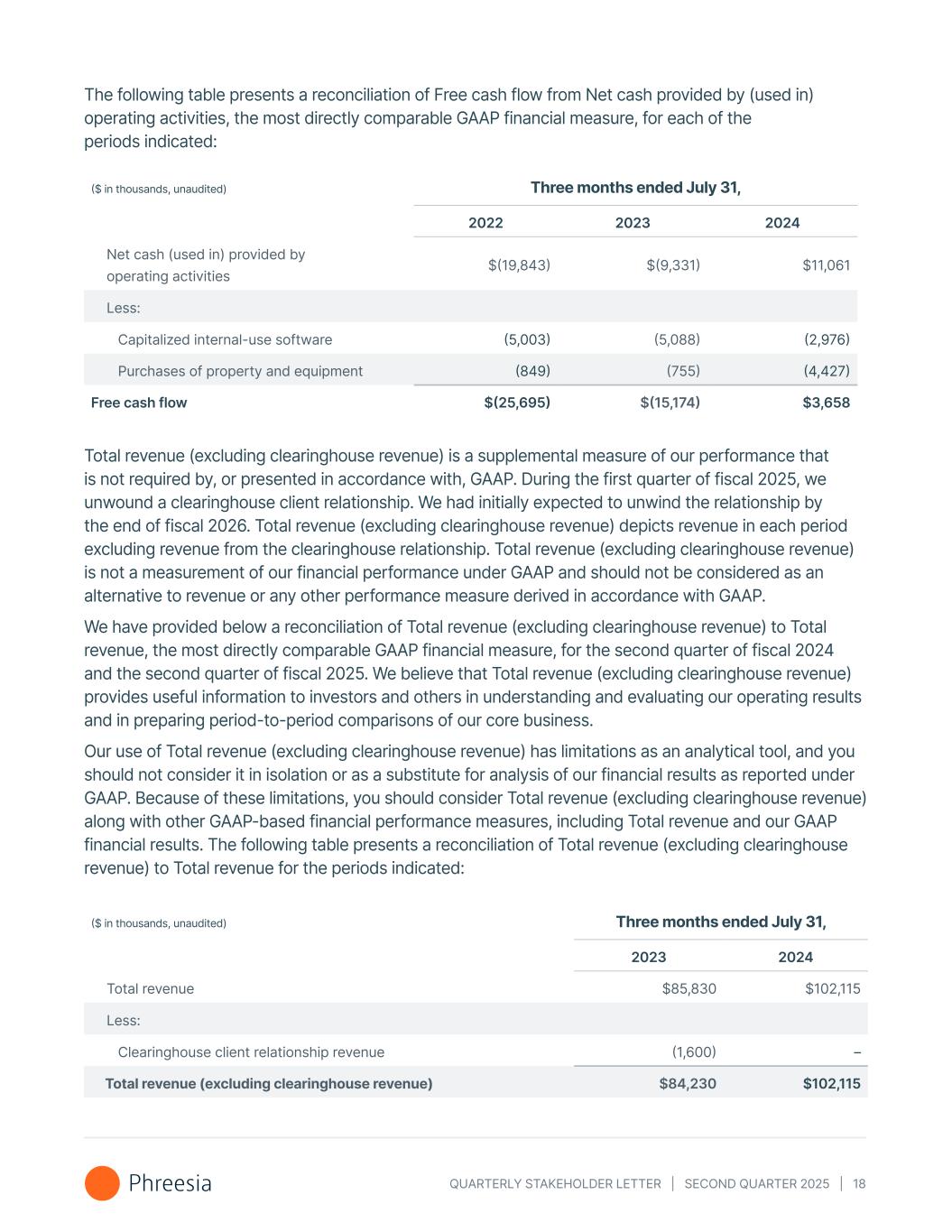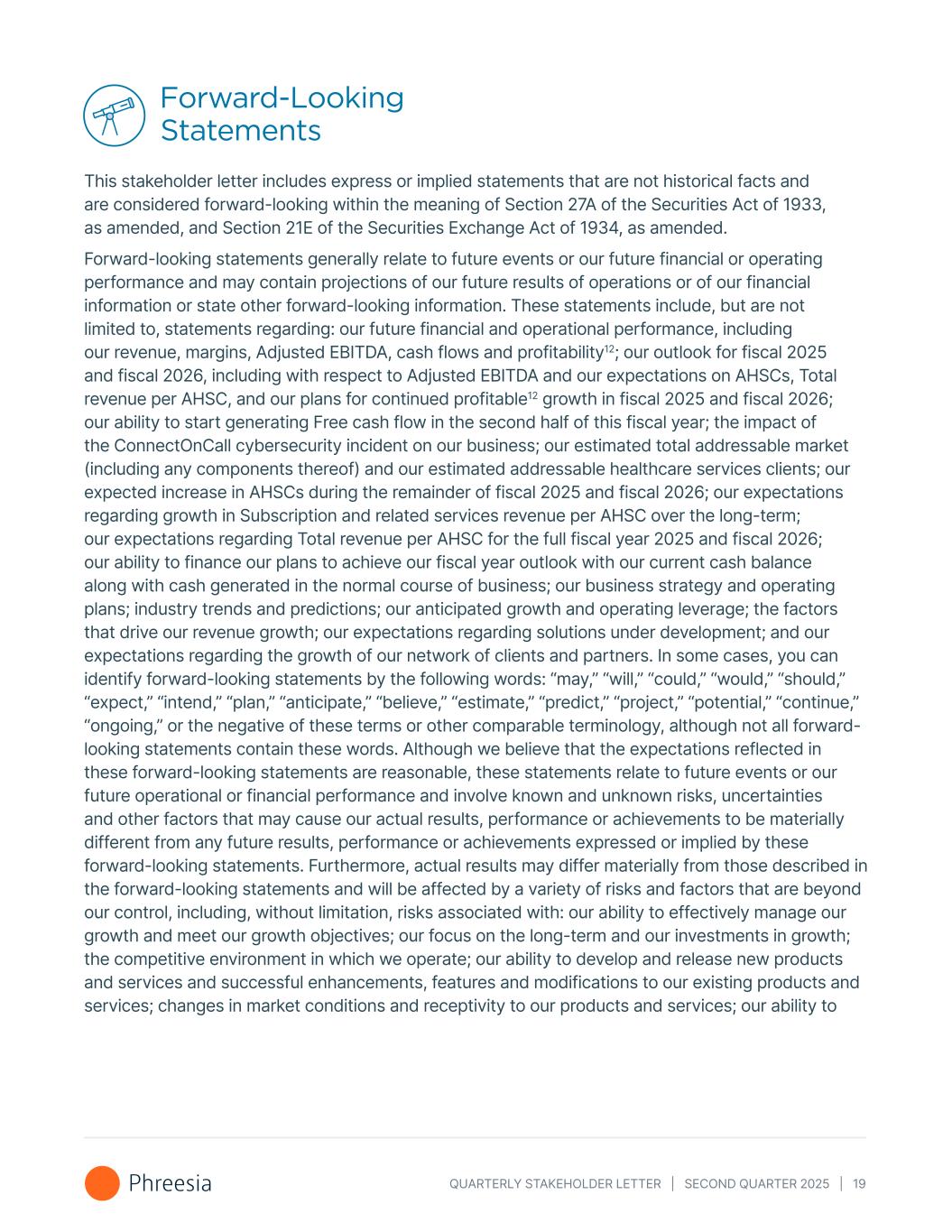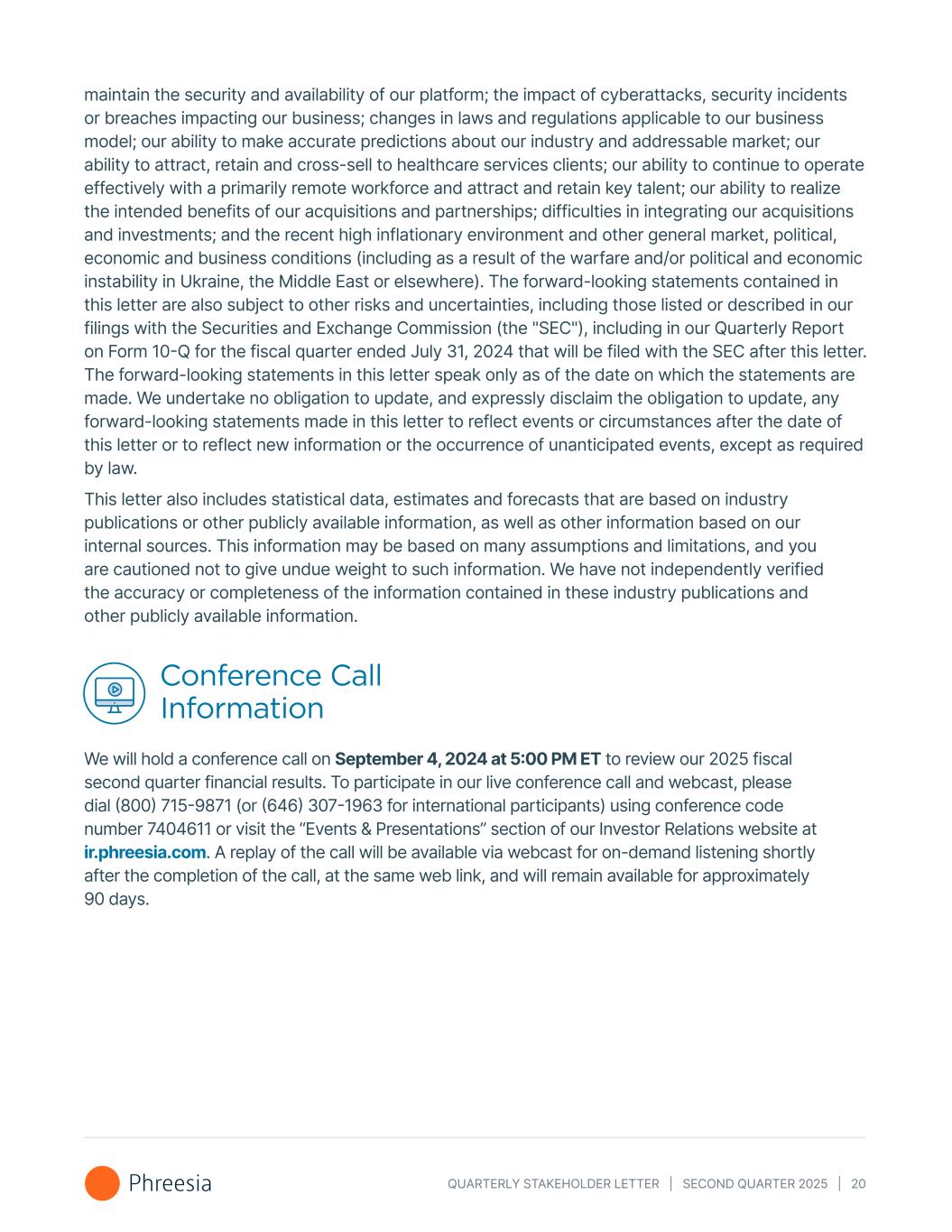Document
Exhibit 99.1
Phreesia Announces Second Quarter Fiscal 2025 Results
ALL-REMOTE COMPANY/WILMINGTON, DE, September 4, 2024 – Phreesia, Inc. (NYSE: PHR) (“Phreesia” or the "Company") announced financial results today for the fiscal second quarter ended July 31, 2024.
"We reached another very important milestone in Phreesia’s evolution by crossing over to positive Free cash flow1 in the fiscal second quarter of 2025,” said CEO and Co-Founder Chaim Indig. “We believe this milestone marks the start of a new era for Phreesia in which we are able to deploy internally generated cash to drive stakeholder value.”
Please visit the Phreesia investor relations website at ir.phreesia.com to view the Company's Q2 Fiscal Year 2025 Stakeholder Letter.
Fiscal Second Quarter Ended July 31, 2024 Highlights
•Total revenue was $102.1 million in the quarter, up 19% year-over-year.
•Average number of healthcare services clients ("AHSCs") was 4,169 in the quarter, up 21% year-over-year.
•Total revenue per AHSC was $24,494 in the quarter, down 2% year-over-year. See "Key Metrics" below for additional information.
•Healthcare services revenue per AHSC was $17,729 in the quarter, down 3% year-over-year. See "Key Metrics" below for additional information.
•Net loss was $18.0 million in the quarter compared to net loss of $36.8 million in the same period in the prior year.
•Adjusted EBITDA was $6.5 million in the quarter compared to negative $11.5 million in the same period in the prior year.
•Net cash provided by operating activities was $11.1 million for the three months ended July 31, 2024, as compared to net cash used in operating activities of $9.3 million for the three months ended July 31, 2023.
•Free cash flow was $3.7 million for the three months ended July 31, 2024, as compared to negative $15.2 million for the three months ended July 31, 2023.
•Cash and cash equivalents as of July 31, 2024 was $81.8 million, a decrease of $5.7 million from January 31, 2024 and up $2.3 million from April 30, 2024.
Fiscal Year 2025 and 2026 Outlook
We are maintaining our revenue outlook for fiscal 2025 of $416 million to $426 million, implying year-over-year growth of 17% to 20%.
We are updating our Adjusted EBITDA outlook for fiscal 2025 to a range of $26 million to $31 million from a previous range of $21 million to $26 million. Our outlook reflects our strong performance in the fiscal second quarter and our continued focus on margin improvement.
We expect AHSCs to reach approximately 4,200 for fiscal 2025 compared to 3,601 for fiscal 2024. We expect Total revenue per AHSC to increase in fiscal 2025 compared to the $98,944 we achieved in fiscal 2024.
We expect AHSCs to reach approximately 4,500 in fiscal 2026. Additionally, we expect Total revenue per AHSC in fiscal 2026 to increase from fiscal 2025.
We believe our $81.8 million in cash and cash equivalents as of July 31, 2024, along with cash generated in our normal operations, gives us sufficient flexibility to reach our fiscal 2025 and fiscal 2026 outlook. Additionally, our available borrowing capacity under our credit facility with Capital One provides us with an additional source of capital to pursue future growth opportunities not incorporated into our fiscal 2025 and fiscal 2026 outlook. As of July 31, 2024 we have no borrowings outstanding under our credit facility.
1 During the second quarter of fiscal 2025, our net cash provided by operating activities was $11.1 million and our Free cash flow was $3.7 million. We define Free cash flow as net cash provided by (used in) operating activities less cash paid for capitalized internal-use software development costs and cash paid for purchases of property and equipment. See “Non-GAAP Financial Measures” for a reconciliation of Free cash flow to the closest GAAP measure.
Non-GAAP Financial Measures
We have not reconciled our Adjusted EBITDA outlook to GAAP Net income (loss) because we do not provide an outlook for GAAP Net income (loss) due to the uncertainty and potential variability of Other (income) expense, net and (Benefit from) provision for income taxes, which are reconciling items between Adjusted EBITDA and GAAP Net income (loss). Because we cannot reasonably predict such items, a reconciliation of the non-GAAP financial measure outlook to the corresponding GAAP measure is not available without unreasonable effort. We caution, however, that such items could have a significant impact on the calculation of GAAP Net income (loss). For further information regarding the non-GAAP financial measures included in this press release, including a reconciliation of GAAP to non-GAAP financial measures and an explanation of these measures, please see “Non-GAAP financial measures” below.
Available Information
We intend to use our Company website (including our Investor Relations website) as well as our Facebook, X, LinkedIn and Instagram accounts as a means of disclosing material non-public information and for complying with our disclosure obligations under Regulation FD.
Forward Looking Statements
This press release includes express or implied statements that are not historical facts and are considered forward-looking within the meaning of Section 27A of the Securities Act of 1933, as amended and Section 21E of the Securities Exchange Act of 1934, as amended. Forward-looking statements generally relate to future events or our future financial or operating performance and may contain projections of our future results of operations or of our financial information or state other forward-looking information. These statements include, but are not limited to, statements regarding: our future financial and operating performance, including our revenue, margins, Adjusted EBITDA, cash flows and profitability2; our ability to finance our plans to achieve our fiscal 2025 and fiscal 2026 outlook with our current cash balance and cash generated in the normal course of business; and our outlook for fiscal 2025 and fiscal 2026, including our expectations on AHSCs. In some cases, you can identify forward-looking statements by the following words: “may,” “will,” “could,” “would,” “should,” “expect,” “intend,” “plan,” “anticipate,” “believe,” “estimate,” “predict,” “project,” “potential,” “continue,” “ongoing,” or the negative of these terms or other comparable terminology, although not all forward-looking statements contain these words. Although we believe that the expectations reflected in these forward-looking statements are reasonable, these statements relate to future events or our future operational or financial performance and involve known and unknown risks, uncertainties and other factors that may cause our actual results, performance or achievements to be materially different from any future results, performance or achievements expressed or implied by these forward-looking statements. Furthermore, actual results may differ materially from those described in the forward-looking statements and will be affected by a variety of risks and factors that are beyond our control, including, without limitation, risks associated with: our ability to effectively manage our growth and meet our growth objectives; our focus on the long-term and our investments in growth; the competitive environment in which we operate; our ability to comply with the covenants in our credit agreement with Capital One; changes in market conditions and receptivity to our products and services; our ability to develop and release new products and services and successful enhancements, features and modifications to our existing products and services; our ability to maintain the security and availability of our platform; the impact of cyberattacks, security incidents or breaches impacting our business; changes in laws and regulations applicable to our business model; our ability to make accurate predictions about our industry and addressable market; our ability to attract, retain and cross-sell to healthcare services clients; our ability to continue to operate effectively with a primarily remote workforce and attract and retain key talent; our ability to realize the intended benefits of our acquisitions and partnerships; and difficulties in integrating our acquisitions and investments; and the recent high inflationary environment and other general, market, political, economic and business conditions (including as a result of the warfare and/or political and economic instability in Ukraine, the Middle East or elsewhere). The forward-looking statements contained in this press release are also subject to other risks and uncertainties, including those listed or described in our filings with the Securities and Exchange Commission (“SEC”), including in our Quarterly Report on Form 10-Q for the fiscal quarter ended July 31, 2024 that will be filed with the SEC following this press release. The forward-looking statements in this press release speak only as of the date on which the statements are made. We undertake no obligation to update, and expressly disclaim the obligation to update, any forward-looking statements made in this press release to reflect events or circumstances after the date of this press release or to reflect new information or the occurrence of unanticipated events, except as required by law.
2 We define “profitability,” discussed herein, in terms of Adjusted EBITDA. See ‘Non-GAAP Financial Measures’ for a reconciliation of our Net loss to Adjusted EBITDA.
This press release includes certain non-GAAP financial measures as defined by SEC rules. We have provided a reconciliation of those measures to the most directly comparable GAAP measures, with the exception of our Adjusted EBITDA outlook for the reasons described above.
Conference Call Information
We will hold a conference call on Wednesday September 4, 2024 at 5:00 p.m. Eastern Time to review our fiscal 2025 second quarter financial results. To participate in our live conference call and webcast, please dial (800) 715-9871 (or (646) 307-1963 for international participants) using conference code number 7404611 or visit the “Events & Presentations” section of our Investor Relations website at ir.phreesia.com. A replay of the call will be available via webcast for on-demand listening shortly after the completion of the call, at the same web link, and will remain available for approximately 90 days.
About Phreesia
Phreesia is a trusted leader in patient activation, giving providers, life sciences companies, payers and other organizations tools to help patients take a more active role in their care. Founded in 2005, Phreesia enabled approximately 150 million patient visits in 2023—more than 1 in 10 visits across the U.S.—scale that we believe allows us to make meaningful impact. Offering patient-driven digital solutions for intake, outreach, education and more, Phreesia enhances the patient experience, drives efficiency and improves healthcare outcomes.
Investor Relations Contact:
Balaji Gandhi
Phreesia, Inc.
investors@phreesia.com
(929) 506-4950
Media Contact:
Nicole Gist
Phreesia, Inc.
nicole.gist@phreesia.com
(407) 760-6274
Phreesia, Inc.
Consolidated Balance Sheets
(in thousands, except share and per share data)
|
|
|
|
|
|
|
|
|
|
|
|
|
July 31, 2024 |
|
January 31, 2024 |
|
(Unaudited) |
|
|
| Assets |
|
|
|
| Current: |
|
|
|
| Cash and cash equivalents |
$ |
81,798 |
|
|
$ |
87,520 |
|
| Settlement assets |
25,320 |
|
|
28,072 |
|
| Accounts receivable, net of allowance for doubtful accounts of $1,365 and $1,392 as of July 31, 2024 and January 31, 2024, respectively |
61,274 |
|
|
64,863 |
|
| Deferred contract acquisition costs |
841 |
|
|
768 |
|
| Prepaid expenses and other current assets |
11,695 |
|
|
14,461 |
|
| Total current assets |
180,928 |
|
|
195,684 |
|
| Property and equipment, net of accumulated depreciation and amortization of $84,295 and $76,859 as of July 31, 2024 and January 31, 2024, respectively |
20,955 |
|
|
16,902 |
|
| Capitalized internal-use software, net of accumulated amortization of $50,559 and $45,769 as of July 31, 2024 and January 31, 2024, respectively |
49,767 |
|
|
46,139 |
|
| Operating lease right-of-use assets |
1,863 |
|
|
266 |
|
| Deferred contract acquisition costs |
742 |
|
|
986 |
|
| Intangible assets, net of accumulated amortization of $6,666 and $4,925 as of July 31, 2024 and January 31, 2024, respectively |
29,884 |
|
|
31,625 |
|
| Goodwill |
75,845 |
|
|
75,845 |
|
| Other assets |
2,251 |
|
|
2,879 |
|
| Total Assets |
$ |
362,235 |
|
|
$ |
370,326 |
|
| Liabilities and Stockholders’ Equity |
|
|
|
| Current: |
|
|
|
| Settlement obligations |
$ |
25,320 |
|
|
$ |
28,072 |
|
| Current portion of finance lease liabilities and other debt |
7,161 |
|
|
6,056 |
|
| Current portion of operating lease liabilities |
989 |
|
|
393 |
|
| Accounts payable |
6,976 |
|
|
8,480 |
|
| Accrued expenses |
32,668 |
|
|
37,130 |
|
| Deferred revenue |
21,370 |
|
|
24,113 |
|
| Other current liabilities |
7,515 |
|
|
5,875 |
|
| Total current liabilities |
101,999 |
|
|
110,119 |
|
| Long-term finance lease liabilities and other debt |
7,297 |
|
|
5,400 |
|
| Operating lease liabilities, non-current |
1,075 |
|
|
134 |
|
| Long-term deferred revenue |
63 |
|
|
97 |
|
| Long-term deferred tax liabilities |
390 |
|
|
270 |
|
| Other long-term liabilities |
76 |
|
|
2,857 |
|
| Total Liabilities |
110,900 |
|
|
118,877 |
|
| Commitments and contingencies |
|
|
|
| Stockholders’ Equity: |
|
|
|
| Preferred stock, undesignated, $0.01 par value—$20,000,000 shares authorized as of both July 31, 2024 and January 31, 2024; no shares issued or outstanding as of both July 31, 2024 and January 31, 2024 |
— |
|
|
— |
|
| Common stock, $0.01 par value - 500,000,000 shares authorized as of both July 31, 2024 and January 31, 2024; 59,057,170 and 57,709,762 shares issued as of July 31, 2024 and January 31, 2024, respectively |
591 |
|
|
577 |
|
| Additional paid-in capital |
1,076,969 |
|
|
1,039,361 |
|
| Accumulated deficit |
(780,703) |
|
|
(742,969) |
|
| Accumulated other comprehensive loss |
(2) |
|
|
— |
|
| Treasury stock, at cost, 1,355,169 shares as of both July 31, 2024 and January 31, 2024 |
(45,520) |
|
|
(45,520) |
|
| Total Stockholders’ Equity |
251,335 |
|
|
251,449 |
|
| Total Liabilities and Stockholders’ Equity |
$ |
362,235 |
|
|
$ |
370,326 |
|
Phreesia, Inc.
Consolidated Statements of Operations
(Unaudited)
(in thousands, except share and per share data)
|
|
|
|
|
|
|
|
|
|
|
|
|
|
|
|
|
|
|
|
|
|
|
|
|
Three months ended
July 31, |
|
Six months ended
July 31, |
|
2024 |
|
2023 |
|
2024 |
|
2023 |
| Revenue: |
|
|
|
|
|
|
|
| Subscription and related services |
$ |
48,612 |
|
|
$ |
39,301 |
|
|
$ |
95,354 |
|
|
$ |
77,188 |
|
| Payment processing fees |
25,300 |
|
|
23,631 |
|
|
52,360 |
|
|
47,884 |
|
| Network solutions |
28,203 |
|
|
22,898 |
|
|
55,618 |
|
|
44,603 |
|
| Total revenues |
102,115 |
|
|
85,830 |
|
|
203,332 |
|
|
169,675 |
|
| Expenses: |
|
|
|
|
|
|
|
| Cost of revenue (excluding depreciation and amortization) |
16,143 |
|
|
14,449 |
|
|
31,866 |
|
|
29,356 |
|
| Payment processing expense |
16,668 |
|
|
15,852 |
|
|
34,965 |
|
|
31,942 |
|
| Sales and marketing |
30,184 |
|
|
37,244 |
|
|
62,195 |
|
|
74,657 |
|
| Research and development |
29,542 |
|
|
27,471 |
|
|
58,423 |
|
|
53,940 |
|
| General and administrative |
19,497 |
|
|
20,988 |
|
|
38,549 |
|
|
40,865 |
|
| Depreciation |
3,921 |
|
|
4,244 |
|
|
7,445 |
|
|
8,748 |
|
| Amortization |
3,382 |
|
|
2,537 |
|
|
6,531 |
|
|
5,023 |
|
| Total expenses |
119,337 |
|
|
122,785 |
|
|
239,974 |
|
|
244,531 |
|
| Operating loss |
(17,222) |
|
|
(36,955) |
|
|
(36,642) |
|
|
(74,856) |
|
| Other (expense) income, net |
(86) |
|
|
50 |
|
|
(117) |
|
|
8 |
|
| Interest income, net |
46 |
|
|
786 |
|
|
285 |
|
|
1,504 |
|
| Total other (expense) income, net |
(40) |
|
|
836 |
|
|
168 |
|
|
1,512 |
|
| Loss before provision for income taxes |
(17,262) |
|
|
(36,119) |
|
|
(36,474) |
|
|
(73,344) |
|
| Provision for income taxes |
(750) |
|
|
(648) |
|
|
(1,260) |
|
|
(954) |
|
| Net loss |
$ |
(18,012) |
|
|
$ |
(36,767) |
|
|
$ |
(37,734) |
|
|
$ |
(74,298) |
|
| Net loss per share attributable to common stockholders, basic and diluted |
$ |
(0.31) |
|
|
$ |
(0.68) |
|
|
$ |
(0.66) |
|
|
$ |
(1.39) |
|
| Weighted-average common shares outstanding, basic and diluted |
57,502,959 |
|
|
53,794,060 |
|
|
57,089,232 |
|
|
53,574,584 |
|
(1) Our potential dilutive securities have been excluded from the computation of diluted net loss per share as the effect would be to reduce the net loss per share. Therefore, the weighted-average number of common shares outstanding used to calculate both basic and diluted net loss per share attributable to common stockholders is the same. |
Phreesia, Inc.
Consolidated Statements of Comprehensive Loss
(Unaudited)
(in thousands)
|
|
|
|
|
|
|
|
|
|
|
|
|
|
|
|
|
|
|
|
|
|
|
|
|
Three months ended
July 31, |
|
Six months ended
July 31, |
|
2024 |
|
2023 |
|
2024 |
|
2023 |
| Net loss |
$ |
(18,012) |
|
|
$ |
(36,767) |
|
|
$ |
(37,734) |
|
|
$ |
(74,298) |
|
| Other comprehensive loss, net of tax: |
|
|
|
|
|
|
|
| Change in foreign currency translation adjustments, net of tax |
(3) |
|
|
— |
|
|
(2) |
|
|
— |
|
| Other comprehensive loss, net of tax |
(3) |
|
|
— |
|
|
(2) |
|
|
— |
|
| Comprehensive loss |
$ |
(18,015) |
|
|
$ |
(36,767) |
|
|
$ |
(37,736) |
|
|
$ |
(74,298) |
|
Phreesia, Inc.
Consolidated Statements of Cash Flows
(Unaudited)
(in thousands)
|
|
|
|
|
|
|
|
|
|
|
|
|
|
|
|
|
|
|
|
|
|
|
|
| |
Three months ended
July 31, |
|
Six months ended
July 31, |
| |
2024 |
|
2023 |
|
2024 |
|
2023 |
| Operating activities: |
|
|
|
|
|
|
|
| Net loss |
$ |
(18,012) |
|
|
$ |
(36,767) |
|
|
$ |
(37,734) |
|
|
$ |
(74,298) |
|
| Adjustments to reconcile net loss to net cash provided by (used in) operating activities: |
|
|
|
|
|
|
|
| Depreciation and amortization |
7,303 |
|
|
6,781 |
|
|
13,976 |
|
|
13,771 |
|
| Stock-based compensation expense |
16,448 |
|
|
18,648 |
|
|
33,288 |
|
|
35,786 |
|
| Amortization of deferred financing costs and debt discount |
51 |
|
|
84 |
|
|
112 |
|
|
169 |
|
| Cost of Phreesia hardware purchased by customers |
334 |
|
|
234 |
|
|
677 |
|
|
650 |
|
| Deferred contract acquisition costs amortization |
192 |
|
|
280 |
|
|
384 |
|
|
620 |
|
| Non-cash operating lease expense |
188 |
|
|
109 |
|
|
361 |
|
|
342 |
|
| Deferred taxes |
56 |
|
|
(75) |
|
|
119 |
|
|
142 |
|
| Changes in operating assets and liabilities: |
|
|
|
|
|
|
|
| Accounts receivable |
4,976 |
|
|
(832) |
|
|
3,583 |
|
|
(2,370) |
|
| Prepaid expenses and other assets |
2,867 |
|
|
(383) |
|
|
3,281 |
|
|
769 |
|
| Deferred contract acquisition costs |
(213) |
|
|
— |
|
|
(213) |
|
|
— |
|
| Accounts payable |
1,186 |
|
|
568 |
|
|
(1,750) |
|
|
(2,415) |
|
| Accrued expenses and other liabilities |
(1,392) |
|
|
4,239 |
|
|
(2,547) |
|
|
6,061 |
|
| Lease liabilities |
(201) |
|
|
(405) |
|
|
(420) |
|
|
(652) |
|
| Deferred revenue |
(2,722) |
|
|
(1,812) |
|
|
(2,777) |
|
|
(1,565) |
|
| Net cash provided by (used in) operating activities |
11,061 |
|
|
(9,331) |
|
|
10,340 |
|
|
(22,990) |
|
| Investing activities: |
|
|
|
|
|
|
|
| Acquisitions, net of cash acquired |
— |
|
|
(3,873) |
|
|
— |
|
|
(3,873) |
|
| Capitalized internal-use software |
(2,976) |
|
|
(5,088) |
|
|
(7,546) |
|
|
(9,820) |
|
| Purchases of property and equipment |
(4,427) |
|
|
(755) |
|
|
(5,303) |
|
|
(2,102) |
|
| Net cash used in investing activities |
(7,403) |
|
|
(9,716) |
|
|
(12,849) |
|
|
(15,795) |
|
| Financing activities: |
|
|
|
|
|
|
|
| Proceeds from issuance of common stock upon exercise of stock options |
219 |
|
|
426 |
|
|
566 |
|
|
675 |
|
| Treasury stock to satisfy tax withholdings on stock compensation awards |
— |
|
|
(3,775) |
|
|
— |
|
|
(10,725) |
|
| Proceeds from employee stock purchase plan |
690 |
|
|
896 |
|
|
1,603 |
|
|
1,863 |
|
| Finance lease payments |
(1,995) |
|
|
(1,983) |
|
|
(3,275) |
|
|
(3,427) |
|
| Constructive financing |
— |
|
|
1,688 |
|
|
— |
|
|
1,688 |
|
| Principal payments on financing agreements |
(295) |
|
|
(45) |
|
|
(584) |
|
|
(45) |
|
| Debt issuance costs and loan facility fee payments |
— |
|
|
(250) |
|
|
(152) |
|
|
(250) |
|
| Financing payments of acquisition-related liabilities |
— |
|
|
— |
|
|
(1,364) |
|
|
— |
|
| Net cash used in financing activities |
(1,381) |
|
|
(3,043) |
|
|
(3,206) |
|
|
(10,221) |
|
| Effect of exchange rate changes on cash and cash equivalents |
(6) |
|
|
— |
|
|
(7) |
|
|
— |
|
| Net increase (decrease) in cash and cash equivalents |
2,271 |
|
|
(22,090) |
|
|
(5,722) |
|
|
(49,006) |
|
| Cash and cash equivalents – beginning of period |
79,527 |
|
|
149,767 |
|
|
87,520 |
|
|
176,683 |
|
| Cash and cash equivalents – end of period |
$ |
81,798 |
|
|
$ |
127,677 |
|
|
$ |
81,798 |
|
|
$ |
127,677 |
|
|
|
|
|
|
|
|
|
|
|
|
|
|
|
|
|
|
|
|
|
|
|
|
|
|
|
|
|
|
|
|
|
|
|
|
|
|
|
|
|
|
|
|
|
|
|
|
|
|
|
|
|
|
|
|
|
| Supplemental information of non-cash investing and financing information: |
|
|
|
|
|
|
|
| Right of use assets acquired in exchange for operating lease liabilities |
$ |
1,194 |
|
|
$ |
— |
|
|
$ |
1,958 |
|
|
$ |
— |
|
| Property and equipment acquisitions through finance leases |
$ |
333 |
|
|
$ |
— |
|
|
$ |
6,862 |
|
|
$ |
7,067 |
|
| Purchase of property and equipment and capitalized software included in current liabilities |
$ |
1,517 |
|
|
$ |
1,509 |
|
|
$ |
1,517 |
|
|
$ |
1,509 |
|
| Capitalized stock-based compensation |
$ |
315 |
|
|
$ |
377 |
|
|
$ |
663 |
|
|
$ |
714 |
|
| Issuance of stock to settle liabilities for stock-based compensation |
$ |
1,649 |
|
|
$ |
1,924 |
|
|
$ |
7,826 |
|
|
$ |
7,221 |
|
| Issuance of stock as consideration in business combinations |
$ |
— |
|
|
$ |
4,676 |
|
|
$ |
— |
|
|
$ |
4,676 |
|
| Issuance of liabilities as consideration in business combinations |
$ |
— |
|
|
$ |
91 |
|
|
$ |
— |
|
|
$ |
91 |
|
| Capitalized software acquired through vendor financing |
$ |
— |
|
|
$ |
2,047 |
|
|
$ |
— |
|
|
$ |
2,047 |
|
| Cash paid for: |
|
|
|
|
|
|
|
| Interest |
$ |
381 |
|
|
$ |
296 |
|
|
$ |
864 |
|
|
$ |
354 |
|
| Income taxes |
$ |
417 |
|
|
$ |
13 |
|
|
$ |
2,010 |
|
|
$ |
53 |
|
Non-GAAP Financial Measures
This press release and statements made during the above-referenced webcast may include certain non-GAAP financial measures as defined by SEC rules.
Adjusted EBITDA is a supplemental measure of our performance that is not required by, or presented in accordance with, GAAP. Adjusted EBITDA is not a measurement of our financial performance under GAAP and should not be considered as an alternative to net income or loss or any other performance measure derived in accordance with GAAP, or as an alternative to cash flows from operating activities as a measure of our liquidity. We define Adjusted EBITDA as net income or loss before interest income, net, provision for income taxes, depreciation and amortization, and before stock-based compensation expense and other expense, net.
We have provided below a reconciliation of Adjusted EBITDA to net loss, the most directly comparable GAAP financial measure. We have presented Adjusted EBITDA in this press release and our Quarterly Report on Form 10-Q to be filed after this press release because it is a key measure used by our management and board of directors to understand and evaluate our core operating performance and trends, to prepare and approve our annual budget, and to develop short and long-term operational plans. In particular, we believe that the exclusion of the amounts eliminated in calculating Adjusted EBITDA can provide a useful measure for period-to-period comparisons of our core business. Accordingly, we believe that Adjusted EBITDA provides useful information to investors and others in understanding and evaluating our operating results in the same manner as our management and board of directors. We have not reconciled our Adjusted EBITDA outlook to GAAP Net income (loss) because we do not provide an outlook for GAAP Net income (loss) due to the uncertainty and potential variability of Other (income) expense, net and (Benefit from) provision for income taxes, which are reconciling items between Adjusted EBITDA and GAAP Net income (loss). Because we cannot reasonably predict such items, a reconciliation of the non-GAAP financial measure outlook to the corresponding GAAP measure is not available without unreasonable effort. We caution, however, that such items could have a significant impact on the calculation of GAAP Net income (loss).
Our use of Adjusted EBITDA has limitations as an analytical tool, and you should not consider it in isolation or as a substitute for analysis of our financial results as reported under GAAP. Some of these limitations are as follows:
•Although depreciation and amortization expense are non-cash charges, the assets being depreciated and amortized may have to be replaced in the future, and Adjusted EBITDA does not reflect cash capital expenditure requirements for such replacements or for new capital expenditure requirements;
•Adjusted EBITDA does not reflect: (1) changes in, or cash requirements for, our working capital needs; (2) the potentially dilutive impact of non-cash stock-based compensation; (3) tax payments that may represent a reduction in cash available to us; or (4) interest income, net; and
•Other companies, including companies in our industry, may calculate Adjusted EBITDA or similarly titled measures differently, which reduces its usefulness as a comparative measure.
Because of these and other limitations, you should consider Adjusted EBITDA along with other GAAP-based financial performance measures, including various cash flow metrics, net loss, and our GAAP financial results. The following table presents a reconciliation of Adjusted EBITDA to net loss for each of the periods indicated:
Phreesia, Inc.
Adjusted EBITDA
(Unaudited)
|
|
|
|
|
|
|
|
|
|
|
|
|
|
|
|
|
|
|
|
|
|
|
|
|
Three months ended
July 31, |
|
Six months ended
July 31, |
| (in thousands) |
2024 |
|
2023 |
|
2024 |
|
2023 |
| Net loss |
$ |
(18,012) |
|
|
$ |
(36,767) |
|
|
$ |
(37,734) |
|
|
$ |
(74,298) |
|
| Interest income, net |
(46) |
|
|
(786) |
|
|
(285) |
|
|
(1,504) |
|
| Provision for income taxes |
750 |
|
|
648 |
|
|
1,260 |
|
|
954 |
|
| Depreciation and amortization |
7,303 |
|
|
6,781 |
|
|
13,976 |
|
|
13,771 |
|
| Stock-based compensation expense |
16,448 |
|
|
18,648 |
|
|
33,288 |
|
|
35,786 |
|
| Other expense (income), net |
86 |
|
|
(50) |
|
|
117 |
|
|
(8) |
|
| Adjusted EBITDA |
$ |
6,529 |
|
|
$ |
(11,526) |
|
|
$ |
10,622 |
|
|
$ |
(25,299) |
|
We calculate Free cash flow as Net cash provided by (used in) operating activities less capitalized internal-use software development costs and purchases of property and equipment.
Additionally, Free cash flow is a supplemental measure of our performance that is not required by, or presented in accordance with, GAAP. We consider Free cash flow to be a liquidity measure that provides useful information to management and investors about the amount of cash generated by our business that can be used for strategic opportunities, including investing in our business, making strategic investments, partnerships and acquisitions and strengthening our financial position.
The following table presents a reconciliation of Free cash flow from Net cash provided by (used in) operating activities, the most directly comparable GAAP financial measure, for each of the periods indicated:
Phreesia, Inc.
Free cash flow
(Unaudited)
|
|
|
|
|
|
|
|
|
|
|
|
|
|
|
|
|
|
|
|
|
|
|
|
| |
Three months ended
July 31, |
|
Six months ended
July 31, |
| (in thousands, unaudited) |
2024 |
|
2023 |
|
2024 |
|
2023 |
| Net cash provided by (used in) operating activities |
$ |
11,061 |
|
|
$ |
(9,331) |
|
|
$ |
10,340 |
|
|
$ |
(22,990) |
|
| Less: |
|
|
|
|
|
|
|
| Capitalized internal-use software |
(2,976) |
|
|
(5,088) |
|
|
(7,546) |
|
|
(9,820) |
|
| Purchases of property and equipment |
(4,427) |
|
|
(755) |
|
|
(5,303) |
|
|
(2,102) |
|
| Free cash flow |
$ |
3,658 |
|
|
$ |
(15,174) |
|
|
$ |
(2,509) |
|
|
$ |
(34,912) |
|
Phreesia, Inc.
Reconciliation of GAAP and Adjusted Operating Expenses
(Unaudited)
|
|
|
|
|
|
|
|
|
|
|
|
|
|
|
|
|
|
|
|
|
|
|
|
| |
Three months ended
July 31, |
|
Six months ended
July 31, |
| (in thousands) |
2024 |
|
2023 |
|
2024 |
|
2023 |
| GAAP operating expenses |
|
|
|
|
|
|
|
| General and administrative |
$ |
19,497 |
|
|
$ |
20,988 |
|
|
$ |
38,549 |
|
|
$ |
40,865 |
|
| Sales and marketing |
30,184 |
|
|
37,244 |
|
|
62,195 |
|
|
74,657 |
|
| Research and development |
29,542 |
|
|
27,471 |
|
|
58,423 |
|
|
53,940 |
|
| Cost of revenue (excluding depreciation and amortization) |
16,143 |
|
|
14,449 |
|
|
31,866 |
|
|
29,356 |
|
|
$ |
95,366 |
|
|
$ |
100,152 |
|
|
$ |
191,033 |
|
|
$ |
198,818 |
|
| Stock compensation included in GAAP operating expenses |
|
|
|
|
|
|
|
| General and administrative |
$ |
6,276 |
|
|
$ |
5,747 |
|
|
$ |
12,485 |
|
|
$ |
11,625 |
|
| Sales and marketing |
5,303 |
|
|
7,111 |
|
|
11,069 |
|
|
13,528 |
|
| Research and development |
3,629 |
|
|
4,563 |
|
|
7,256 |
|
|
8,441 |
|
| Cost of revenue (excluding depreciation and amortization) |
1,240 |
|
|
1,227 |
|
|
2,478 |
|
|
2,192 |
|
|
$ |
16,448 |
|
|
$ |
18,648 |
|
|
$ |
33,288 |
|
|
$ |
35,786 |
|
| Adjusted operating expenses |
|
|
|
|
|
|
|
| General and administrative |
$ |
13,221 |
|
|
$ |
15,241 |
|
|
$ |
26,064 |
|
|
$ |
29,240 |
|
| Sales and marketing |
24,881 |
|
|
30,133 |
|
|
51,126 |
|
|
61,129 |
|
| Research and development |
25,913 |
|
|
22,908 |
|
|
51,167 |
|
|
45,499 |
|
| Cost of revenue (excluding depreciation and amortization) |
14,903 |
|
|
13,222 |
|
|
29,388 |
|
|
27,164 |
|
|
$ |
78,918 |
|
|
$ |
81,504 |
|
|
$ |
157,745 |
|
|
$ |
163,032 |
|
Phreesia, Inc.
Key Metrics
(Unaudited)
|
|
|
|
|
|
|
|
|
|
|
|
|
|
|
|
|
|
|
|
|
|
|
|
|
Three months ended
July 31, |
|
Six months ended
July 31, |
|
2024 |
|
2023 |
|
2024 |
|
2023 |
| Key Metrics: |
|
|
|
|
|
|
|
| Average number of healthcare services clients ("AHSCs") |
4,169 |
|
|
3,445 |
|
|
4,117 |
|
|
3,377 |
|
| Healthcare services revenue per AHSC |
$ |
17,729 |
|
|
$ |
18,268 |
|
|
$ |
35,879 |
|
|
$ |
37,036 |
|
| Total revenue per AHSC |
$ |
24,494 |
|
|
$ |
24,914 |
|
|
$ |
49,388 |
|
|
$ |
50,244 |
|
The definitions of our key metrics are presented below.
•AHSCs. We define AHSCs as the average number of clients that generate subscription and related services or payment processing revenue each month during the applicable period. In cases where we act as a subcontractor providing white-label services to our partner's clients, we treat the contractual relationship as a single healthcare services client. We believe growth in AHSCs is a key indicator of the performance of our business and depends, in part, on our ability to successfully develop and market our solutions to healthcare services organizations that are not yet clients. While growth in AHSCs is an important indicator of expected revenue growth, it also informs our management of the areas of our business that will require further investment to support expected future AHSC growth. For example, as AHSCs increase, we may need to add to our customer support team and invest to maintain effectiveness and performance of our solutions for our healthcare services clients and their patients.
•Healthcare services revenue per AHSC. We define Healthcare services revenue as the sum of subscription and related services revenue and payment processing revenue. We define Healthcare services revenue per AHSC as Healthcare services revenue in a given period divided by AHSCs during that same period. We are focused on continually delivering value to our healthcare services clients and believe that our ability to increase Healthcare services revenue per AHSC is an indicator of the long-term value of our solutions.
•Total revenue per AHSC. We define Total revenue per AHSC as Total revenue in a given period divided by AHSCs during that same period. Our healthcare services clients directly generate subscription and related services and payment processing revenue. Additionally, our relationships with healthcare services clients who subscribe to our solutions give us the opportunity to engage with life sciences companies, health plans and other payer organizations, patient advocacy, public interest and other not-for-profit organizations who deliver direct communication to patients through our solutions. As a result, we believe that our ability to increase Total revenue per AHSC is an indicator of the long-term value of our solutions.
Additional Information
(Unaudited)
|
|
|
|
|
|
|
|
|
|
|
|
|
|
|
|
|
|
|
|
|
|
|
|
|
Three months ended
July 31, |
|
Six months ended
July 31, |
|
2024 |
|
2023 |
|
2024 |
|
2023 |
| Patient payment volume (in millions) |
$ |
1,093 |
|
|
$ |
989 |
|
|
$ |
2,259 |
|
|
$ |
2,005 |
|
| Payment facilitator volume percentage |
81 |
% |
|
82 |
% |
|
81 |
% |
|
82 |
% |
•Patient payment volume. We believe that patient payment volume is an indicator of both the underlying health of our healthcare services clients’ businesses and the continuing shift of healthcare costs to patients. We measure patient payment volume as the total dollar volume of transactions between our healthcare services clients and their patients utilizing our payment platform, including via credit and debit cards that we process as a payment facilitator as well as cash and check payments and credit and debit transactions for which we act as a gateway to other payment processors.
•Payment facilitator volume percentage. We define payment facilitator volume percentage as the volume of credit and debit card patient payment volume that we process as a payment facilitator as a percentage of total patient payment volume. Payment facilitator volume is a major driver of our payment processing revenue. Our payment facilitator volume percentage could decline slightly over time should we increase our penetration of enterprise customers that are less likely to use Phreesia as a payment facilitator.

